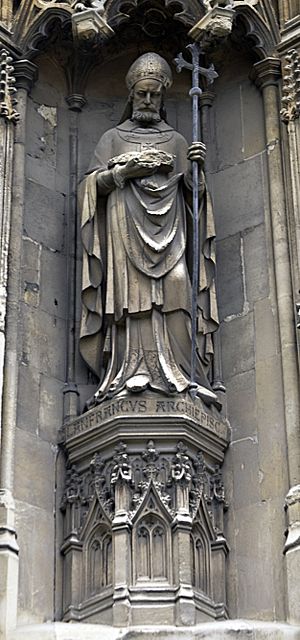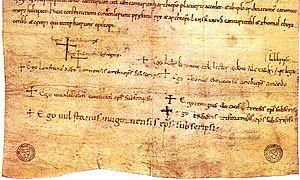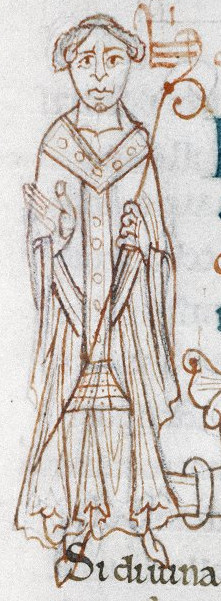Lanfranc facts for kids
Quick facts for kids Lanfranc |
|
|---|---|
| Archbishop of Canterbury | |

Statue of Lanfranc from the exterior of Canterbury Cathedral
|
|
| Appointed | August 1070 |
| Reign ended | 24 May 1089 |
| Predecessor | Stigand |
| Successor | Anselm of Canterbury |
| Other posts | Abbot of Saint-Étienne, Caen |
| Orders | |
| Consecration | 15 August 1070 |
| Personal details | |
| Born | between 1005 and 1010 Pavia, Holy Roman Empire |
| Died | 24 May 1089 (aged 79-84) Canterbury, Kingdom of England |
| Buried | Canterbury Cathedral, Canterbury, England |
| Nationality | Italian |
| Denomination | Roman Catholic Church |
| Parents | Hanbald |
| Sainthood | |
| Feast day | May 28 |
| Venerated in | Roman Catholic Church, Anglican Communion |
| Title as Saint | Bishop, Monk, Scholar |
| Beatified | After the Council of Trent |
| Attributes | book, cross, episcopal vestments |
| Patronage | The Archbishop Lanfranc Academy |
| Shrines | Canterbury Cathedral |
Lanfranc (born between 1005 and 1010 – died May 24, 1089) was an important Italian scholar. He gave up his career as a lawyer to become a Benedictine monk. He lived at Bec Abbey in Normandy.
Lanfranc held several important church positions. He was the prior (a leader) of Bec Abbey. Later, he became the abbot (head) of St Stephen's Abbey in Normandy. After the Norman Conquest, he became the Archbishop of Canterbury in England. He is also known as Lanfranc of Pavia, Lanfranc of Bec, and Lanfranc of Canterbury.
Contents
Early Life and Education
Lanfranc was born in the early 1000s in Pavia, Italy. His father, Hanbald, was said to be like a magistrate or judge. Lanfranc became an orphan when he was young.
He studied the liberal arts, which included grammar, logic, and rhetoric. Northern Italy was famous for this kind of education at the time. Later, he moved across the Alps mountains. He started teaching in France and then in Normandy.
Around 1039, he became the head teacher at the cathedral school in Avranches. He taught there for three successful years. But in 1042, he decided to become a monk. He joined the new Bec Abbey and lived there quietly until 1045.
Teacher and Scholar at Bec
The abbot of Bec, Herluin, convinced Lanfranc to open a school at the abbey. This helped the monastery, which was not very wealthy. Lanfranc quickly became famous as a teacher.
Students came from many places, including France, Normandy, Germany, and Italy. Many of his students later became important church leaders. One student, Anselm of Badagio, became a pope. Another, Anselm of Bec, later took Lanfranc's place as Archbishop of Canterbury.
Lanfranc taught grammar, logic, and rhetoric. He also showed how these subjects could help understand religious ideas. In one of his key works, he explained the letters of Paul the Apostle. He used logic to show Paul's arguments.
Lanfranc was asked to defend a church teaching called transubstantiation. This teaching says that during a religious service, bread and wine truly become the body and blood of Christ. He defended this idea against Berengar of Tours, who was his friend. Lanfranc was a strong supporter of this teaching at church councils in Vercelli (1050), Tours (1054), and Rome (1059).
His work, De corpore et sanguine Domini, became an important textbook. It helped explain the change of the bread and wine using ideas from Aristotle.
Prior and Abbot Roles
Lanfranc became more involved in politics during his time as a church leader. While he was Prior of Bec, he spoke out against Duke William's marriage to Matilda of Flanders in 1053. Their marriage was against church rules because they were related.
However, they settled their disagreement. Lanfranc then helped William get the pope's approval for the marriage. He succeeded at the same council where he debated Berengar (1059). This made William very grateful to Lanfranc.
In 1066, Lanfranc became the first Abbot of the Abbey of Saint-Étienne in Caen, Normandy. Duke William had founded this monastery. From then on, Lanfranc had a strong influence on William's decisions.
William followed church reform ideas and gained the support of Rome for his invasion of England. Pope Alexander II, who might have been Lanfranc's student, gave his blessing to the Norman Conquest. This was a big help to William at the time.
Archbishop of Canterbury
In 1070, Lanfranc was chosen to be the Archbishop of Canterbury. This happened after the previous archbishop, Stigand, was removed. Lanfranc was consecrated (officially made archbishop) on August 29, 1070.
The new archbishop immediately started to reorganize and reform the church. He faced challenges, especially from Thomas of Bayeux, the Archbishop-elect of York. Thomas claimed his church was independent of Canterbury. This started a long argument between the two main churches in England, known as the Canterbury–York dispute.
Lanfranc visited the pope to get his official scarf, called a pallium. The pope ordered that the dispute with York be settled by a council of the English Church. This meeting took place at Winchester in 1072. At this council, Lanfranc's claim to lead the English Church was confirmed.
Lanfranc helped King William keep the English Church independent. He also worked to remove corruption from the church. He strongly supported monasteries. He tried to make sure that priests did not marry.
Lanfranc got the king's permission to hold church meetings called synods. He also used his legal skills to allow bishops to be tried in a lay court (a court run by non-church people). This happened in the cases of Odo of Bayeux (1082) and William of St Calais (1088).
Lanfranc also helped replace English church leaders with Normans. While his choices were usually good, they were not always better than the English leaders they replaced. As the chief church leader, Lanfranc had a strong role in the king's councils. He used his power to help the church in ways that pleased the king. When William I was away from England, Lanfranc often acted as his deputy.
Lanfranc's most important political help to William was in 1075. He discovered and stopped a plot by the earls of Norfolk and Hereford. Waltheof, one of the rebels, told Lanfranc about the plot. Lanfranc urged Roger, the earl of Hereford, to remain loyal to the king. He then officially removed Roger and his supporters from the church. Lanfranc tried to save Waltheof's life and believed he was innocent.
When King William died in 1087, Lanfranc helped William Rufus become the next king. This was despite some nobles not wanting Rufus to rule. In 1088, Lanfranc encouraged the English army to fight for the new king against other nobles. He made Rufus promise to rule fairly. Lanfranc was not afraid to speak up when Rufus broke his promises.
Lanfranc died on May 24, 1089, after getting a fever. People across England were very sad. He was a very important and honest person who helped William I establish Norman rule over the English Church and people. He improved the standards of church discipline and education. His reforms led to some tension between the Church and the State.
Becoming a Saint
People at Christ Church Canterbury tried to get Lanfranc recognized as a saint. His name was later added to the Roman Martyrology, which lists saints and blessed people. In the Catholic Church, he is considered "Blessed," and his feast day is celebrated on May 28.
Modern Commemoration
In 1931, a school called The Archbishop Lanfranc School (now The Archbishop Lanfranc Academy) opened in Croydon. Lanfranc had lived at Croydon Palace there. Canterbury Christ Church University has a building named Lanfranc House. There are also roads named after him in London and Worthing, West Sussex.
The Church of England also remembers Lanfranc with a special commemoration on May 28.
See also
 In Spanish: Lanfranco de Canterbury para niños
In Spanish: Lanfranco de Canterbury para niños
- Correctory



